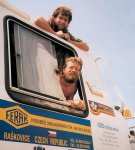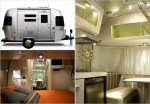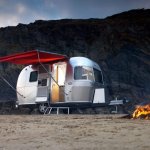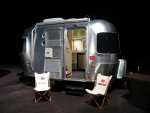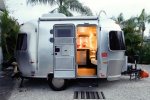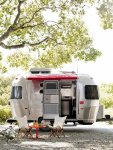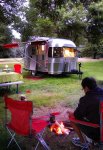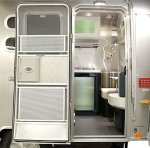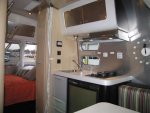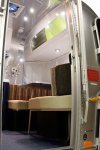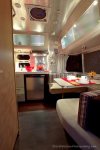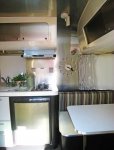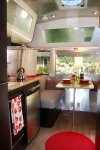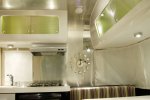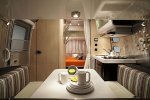Hi
grizzlyj,
Good to hear from you!
Hiya
The Tankograd book on the MAN KAT explains why and how it was possible to build an otherwise too costly truck, and a little about design decisions along the way such as flex/no flex, independent vs beam axle. Printed in English and German it is a very worthwhile read.

I believe Actionmobil use a 12/24v Danfoss compressor kit in an insulated box they build to make best use of space available. I suppose it could also be possible to install this kit into one one the mains powered units you considered as well as its own mechanicals to get the best of both worlds. I do wonder what items you envisage you would put into a massive fridge that would need cooling, that was available and that would last 4 weeks plus? Wothahelizat has part of the floor sandwich space dedicated to home brewing, perhaps downsize the fridge and allow for this?

Thanks for the heads-up about the Tankograd book. I’ve been meaning to order it; now I will.
As regards the refrigerator, just wanted to establish that, in principle, it would be easy enough to install a big Sub-Zero glass-door model, running on 12/24v, as per the Thompson's converted 300 liter Kelvinator refrigerator in
Mañana -- see posts #212, #213, #216, and #217. Or if you are using standard, default ExPo pagination, see
http://www.expeditionportal.com/for...pedition-RV-w-Rigid-Torsion-Free-Frame/page22 .
Why? Well, again, because Sub-Zeros are cool. And because Newell coaches have them. As regards the interior, I am imagining the TerraLiner spec’d out as roughly equivalent to a Newell, albeit with more of an Art Deco, Airstream-glamping sort of interior aesthetic. Like ARC – see
http://www.arcairstreams.co.uk . But granted, for boondocking most of the food carried would not be refrigerated.
Egn and I discussed this at length earlier in the thread; see posts #164, #166, #168, #170, and #173. Or again, if you are using default formatting, see pages 17 and 18, at
http://www.expeditionportal.com/for...pedition-RV-w-Rigid-Torsion-Free-Frame/page17 and
http://www.expeditionportal.com/for...pedition-RV-w-Rigid-Torsion-Free-Frame/page18 . Any expedition vehicle worthy of the name needs to have lots of space for canned goods, and so too, for the kind of vacuum-stored prepared food that
egn and I discussed in those posts.
****************************************************
In an earlier post you suggested that there might be something a bit "Zeitgeist inappropriate" about designing such a large and glam vehicle, given the current economic climate. I never addressed that point, but will try to address it now.

Although we most certainly live in an economically globalized world, the global economy is less "coupled" or unitary than some people tend to imagine. The economic climate does vary across the planet, often significantly so.
For instance, it is fairly indisputable that the 2008 financial meltdown was primarily a crisis whose causal locus was the Anglosphere. Britain and the United States have had "over-financialized" economies for a very long time, Britain especially so. Things have probably reached the point where the over-financialization of Britain has thoroughly corrupted its political process. It will be difficult for Britain to extricate itself from the financial interests that engineered the casino-capitalist laissez-faire conditions that produced the meltdown in the first place, financial interests that want casino-capitalism to continue -- see
http://www.newstatesman.com/business/2013/11/financialisation-everyday-life-must-be-confronted ,
http://www.economicshelp.org/blog/7472/economics/over-financialisation-of-the-economy/ ,
http://hbr.org/2014/06/the-price-of-wall-streets-power/ar/1 ,
http://www.forbes.com/sites/stevedenning/2014/06/03/why-financialization-has-run-amok/ , and
http://en.wikipedia.org/wiki/Financialization .
Economies rooted in decidedly more "old-fashioned" principles -- you know, actually makin' stuff -- have done fairly well since 2008, the German economy often cited as a case in point -- see
http://www.economist.com/node/21552567 . So too the situation of the United States is a bit different than Britain's, because the United States still has a significant manufacturing base, one that has expanded since a falling dollar made American exports cheaper. The American economy has also enjoyed a boost from cheap energy made possible by "shale-gas", in contrast to Britain and the EU. The Euro crisis has of course been very hard for Latin countries in southern Europe whose industries lack traditions of heavy R&D investment, access to cheap long-term capital, and the labor productivity of the north. By which economists mean that although the average southern European works significantly longer hours per week than the average German or Swede, he or she produces less, because Latin investment in R&D has been so comparatively meager. So the Euro crisis is something a bit different from the crisis of over-financializaiton that has beset the Anglosphere.
As for the wider world beyond Europe and North America, although slack Anglospheric and European demand has had an impact on China's rate of growth, what we're talking about here is a "slowdown" (if one call it that) from 10 - 12 % growth per annum, to "just" 6 - 8 % growth per annum -- see
http://www.reuters.com/article/2014/04/16/us-china-economy-gdp-idUSBREA3F04J20140416 . China's economy is still for all intents and purposes booming.
So the economic Zeitgeist might be looking grey and cloudy in Britain, but Britain is not the world, and it would be foolish to design with only British economic weather in mind, so to speak. It would be interesting to know, for instance, the breakdown by nationality of ActionMobil and UniCat customers. One suspects that a significant proportion of UniCat's customers must be middle-eastern, if only because UniCat has opened a fully equipped workshop in Dubai -- see
http://www.unicat.com/pdf/UNICAT-News-2010-01-HI-en.pdf and
http://www.unicat.com/pdf/UNICAT-News-2010-02-HI-en.pdf . The market for expedition vehicles, in short, is global, and a designer needs to keep this in mind.
I hope the previous did not sound too harsh, and I tried to put things as abstractly as I could. But there is really no gentle way to make the points above, is there?
 ....
....For what it's worth, this line of thinking is fairly standard on the continent, and so too amongst many British and American economists. Indeed, this line of thinking is the theoretical basis for Ed Milliband's "Neue Labor" platform -- see
http://www.economist.com/news/21589...-it-become-fairer-and-more-productive-country ,
http://www.spiegel.de/international...rmany-as-an-economic-role-model-a-898399.html ,
http://www.bbc.co.uk/programmes/b01cvkg6 ,
http://www.theguardian.com/politics/2012/jun/01/labour-policy-chief-germany-inspiration , and
http://www.independent.co.uk/voices...wants-us-to-be-more-like-germany-6699327.html . So hope it's not too surprising to see it in print here? We're not supposed to get "political" on ExPo, and one of the reasons I like this web-forum is because it
is so blessedly free of politics. But there is an ethical and a political dimension to transportation design that's kinda unavoidable, although what this actually means in practice often proves to be a bit different than what most people imagine. So let's just say that I've considered such questions, I am very grateful for your thoughtful comments about weight and accessibility, but we'll probably have to agree to disagree.
.. ....
....
However, I want to emphasize that I very much
do value your comments, if only because there is always something to be learnt from those willing to provide constructive criticism. Your thoughts about weight and accessibility have had a big impact on my thinking. I read your posts carefully, and again, I find your observations and criticisms valuable. But needless to say, I've had to balance your arguments against other kinds of information that I've garnered from egn, Peter Thompson, the owners of large MAN-KAT motorhomes who contribute to the kat-forum.de, and the evidence of expeditions like "Overland 12" or "Tatra Around the World".
So, continuing.....
EGN mentioned a while back that there is no diff between his rear axles. Does that mean that a 6x6 made from an 8x8 MAN KAT with rear axle removed would have a better turning circle than a normal 6x6? One post I've read on the KAT forum suggests a 4x4 and an 8x8 are better in sand than the 6x6 but maybe that was more opinion than fact?

At a bare minimum the front two axles of an 8x8 SX-45 or HX-77 are steerable. Ergo, if you cut off the fourth axle of an 8x8, then it seems likely that the resulting 6x6 will probably cut a tighter circle than a 6x6 SX-44 or HX-58, in which only a single front axle steers. But I am not certain about this; you will have to ask
egn.
And whether a MAN-KAT 4x4 or 8x8 is "better in the sand" than a 6x6, that's definitely a question for
egn....
A totally stupid suggestion of mine would be to use a Subaru boxer diesel engine within the chassis rails directly driving one axle each. In total that would give enough power and torque, very compact, and if EGNs truck can manage with two axles scrubbing on corners I would think dissimilar wheel speeds from slightly different engine characteristics could be minor on a truck, or computer controlled for harmony. Rubbish torque curve I imagine for direct connection, but torque converters or hybrid drive and a constant diesel rpm?
This one is way out of my depth; far too technical. Again, I’ll leave it to
egn and others to respond….

The vehicle accessibility thing I think is more of a yes or no rather than a % accessible. Forum posts saying Russian bridges are 3.5m, or African safari parks allow Landrover sized vehicles only, or some 4x4 tracks in Australia allow Landy sized stuff and bigger just won't fit. Something that I've posted before because it surprised me is our 3.9m camper couldn't go to Andorra from France, we would have to have driven all the way around it and down into Spain before coming back up. If your dream trip entails any of the few you can discover before you leave, Biotect's little truck will not be on the shopping list. I wonder how the orange Italian 6x6s would have got on in the mud if they were lightly loaded, 10 tons instead of ???
Accessibility may be “yes/no”, but I am still committed to an
egn-sized vehicle nonetheless, i.e. 9 – 10 m long.
Did you check out
egn's über-cool trip-logs? The 4m high camper-box of
Blue Thunder sure does get around, the East-European 3.5 m bridge-height limit notwithstanding....:smiley_drive:


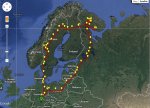

For more about
egn's
Blue Thunder and where it’s been, see
http://www.expeditionportal.com/forum/threads/11614-MAN-6x6-camper ,
http://www.rv.net/forum/index.cfm/fuseaction/thread/tid/20933867/srt/pa/pging/1/page/1.cfm ,
http://www.enfatec.de/index.php?id=54 ,
http://www.poi66.com/show_album.php?album=bt-kola-2007&allow_cookies=1 ,
http://www.poi66.com/show_album?album=bt-irland-2012 ,
http://www.poi66.com/show_album?album=bt-schweden-2011 ,
http://www.poi66.com/show_album.php?album=bt-baltic-2010 ,
http://www.poi66.com/show_album?album=bt-tuerkei-2008 , and
http://www.poi66.com/show_album?album=bt-balkan-2013 .
Also check out the world-travels of the Tatra 815 GTC (
Grand
Touring
Caravan), once I fill in all the pictures for the series of posts above. Not bad for a vehicle that’s 10 m long, and that weighs 22,000 kg. :victory:
Which side the steering wheel is on may be an insistence on the part of the customer, as many without experience will not want to be too far out of their comfort zone perhaps? LHD cars sell very poorly in the UK even with such temptations as the new Corvette Stingray. The height of a truck cab makes steering wheel side fairly irrelevant though, the driver will mostly have a passenger in such a camper, you just have to persuade the customer that its no big deal.
I’ve lived in England off-and-on for almost 6 years in total, and have learned to feel comfortable driving on the wrong side of the road….
 ...
... The only problems seem to arise in the first 24 hours switching from LHS to RHS, or the reverse. The trick I use is simple. No matter where you are driving, if you are the driver, you should always be
“most in harm’s way”, on the side of the vehicle that’s closest to oncoming traffic. Sure, this may sound morbid, but I always ask myself,
“Am I driving on the road in such a manner that in the event of a head-on collision, I will get hammered first?” If not, then I know that I’m on the wrong side. Seems to work, except that I still have nightmares for a few weeks every time I make the switch, dreaming that I screwed up, and am about to hit a big truck face-first.
Thankfully I always wake up from my nightmares before I die.

One place in Morocco we spent some time had bottled water to drink and brackish groundwater. If I had a water filter working on osmosis I think I would have had plenty of drinking water from the wells. The PreMac filter we did have is very effective but doesn't remove salt (or heavy metals come to that), and the element lifespan was reduced by putting this water though it. We didn't know at the time but drinking this filtered ground water gave a mildly upset stomach. I think having a good filter for drinking water most of the time (Seagull IV X-6?), and a means of converting sea water occasionally would be ideal. Coarse filtration into a main tank, proper filtration into a drinking water only tank. I'm not sure about filtering shower water? A drinking water only tank means you could empty the locally bought water bottles into it saving space, and if you keep it full you have a drinkable reservoir in the event of a power or filter failure. Micro Pur Forte powder maintains water quality for six months once its in a clean condition. (A mug sized tub for 50000l has a several year shelf life and costs about €80).
Thanks for all the advice about water filters. I’ve not yet researched water-filtering at length. Right now I am trying to work my way through heating system design for extreme high-altitude. Check out the thread at
http://www.expeditionportal.com/for...ion-for-Heating/page4?highlight=high+altitude , where an extended and very productive correspondence with
julius007 seems to be developing.
Finally, many thanks for this link to the ExPo composting toilet thread. Literally every possible aspect of expedition vehicle design has been or is being discussed on ExPo. Really astonishing, and simply terrific.
Do check out the “High Altitude Heating” thread, and chime in, if you feel moved…. The Tatra 815 GTC chronicled above, it should be noted, seems to have had all-electric heating, and this was pre-solar. No doubt because the Tatra 815 GTC’s intended itinerary took it along most of the length of the Andes, as well as across the Tibetan plateau. At one point in the Andes the Tatra 815 GTC set an altitude record of 5300 m.
All best wishes,
Biotect




